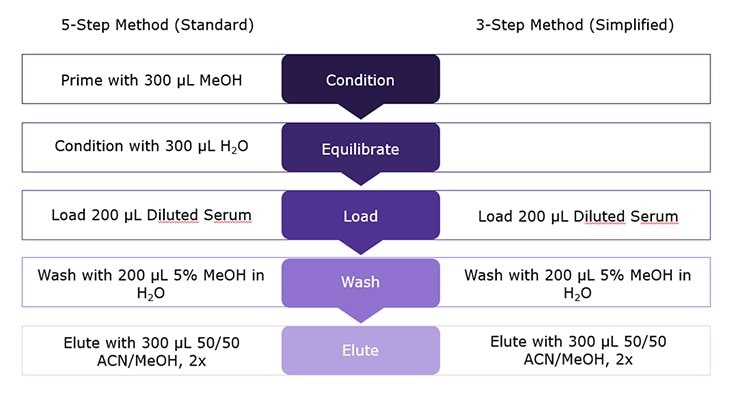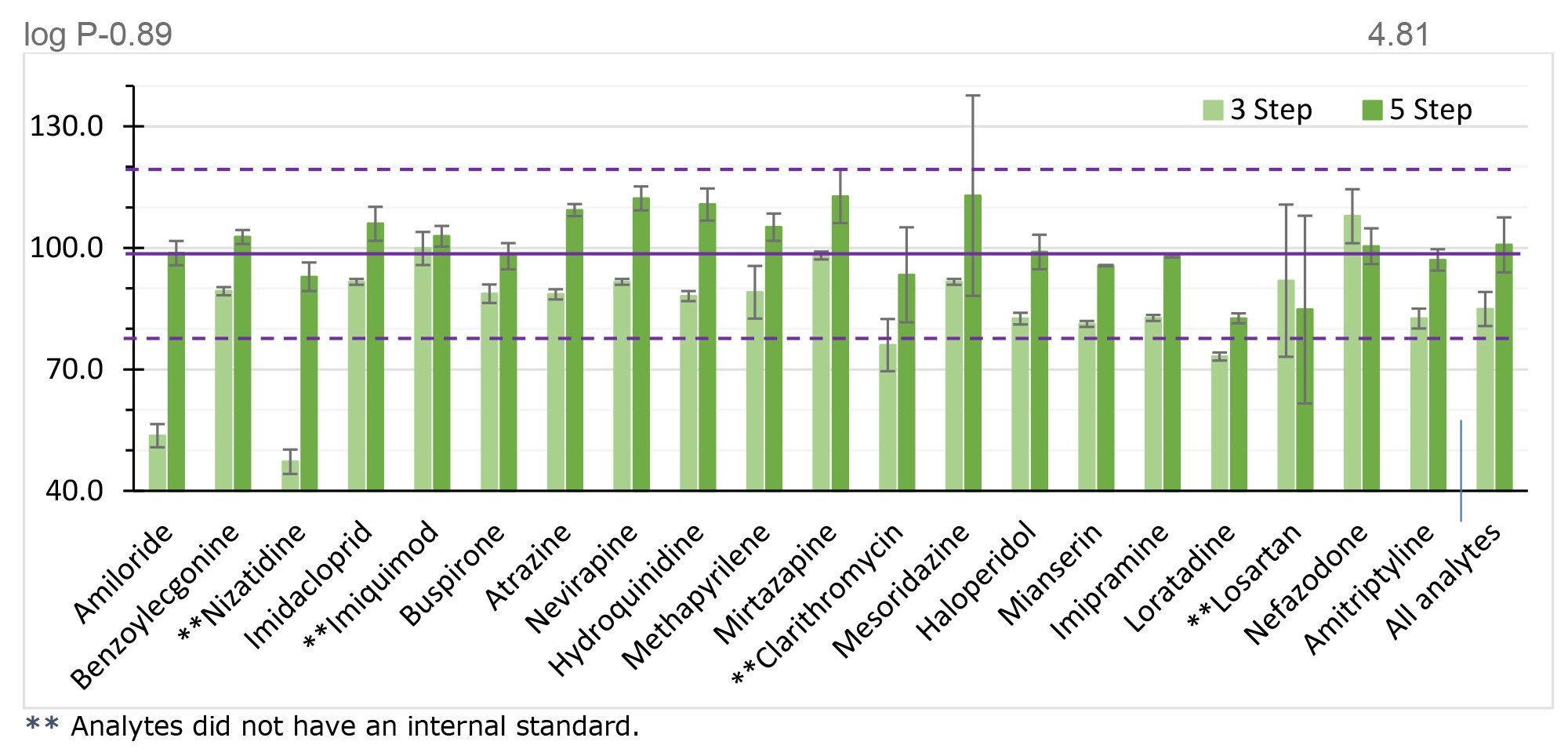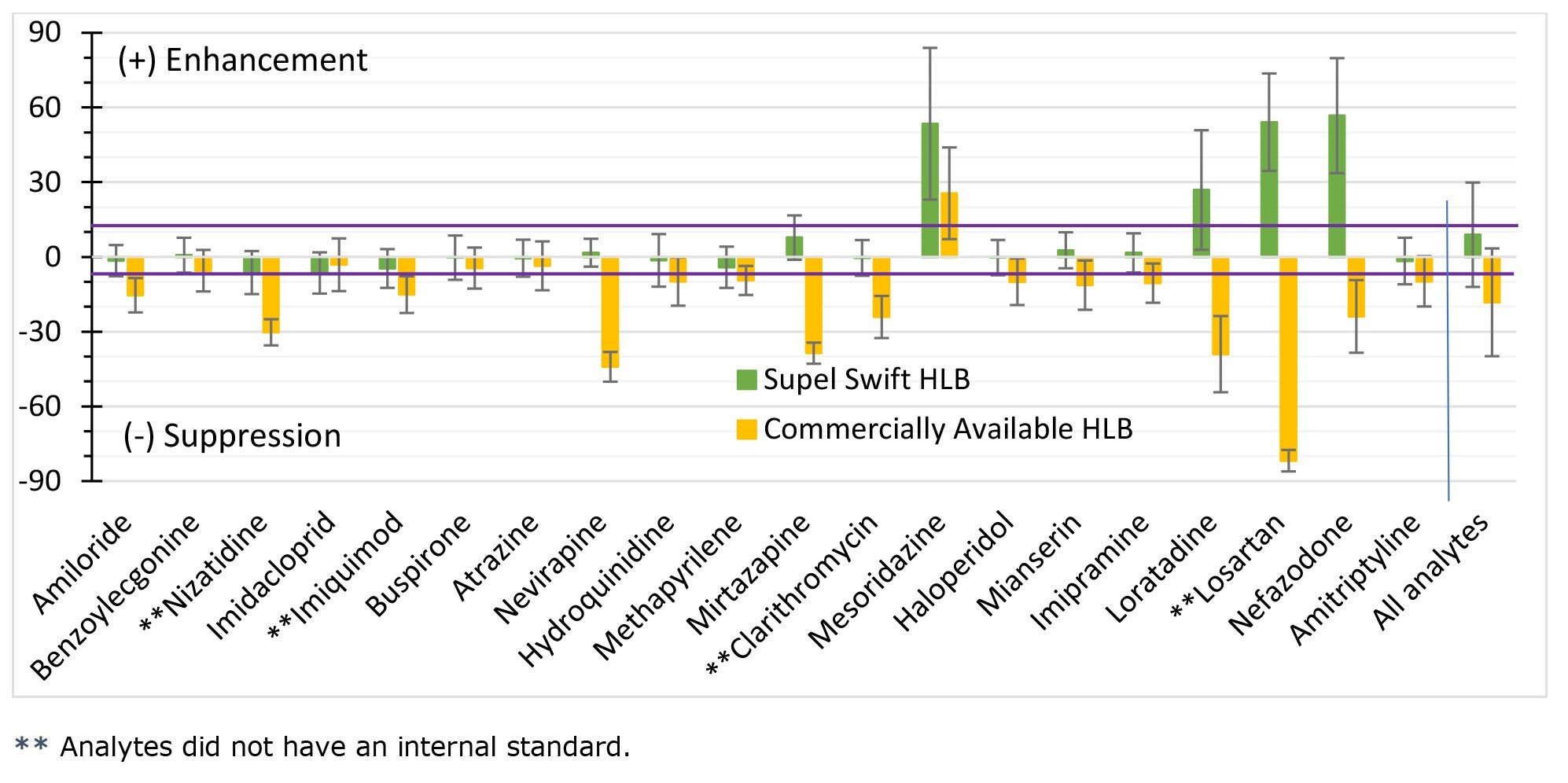Supel™ Swift HLB SPE Cartridges ‒ Solid Phase Extraction (SPE) Made Easy
Supel™ Swift HLB SPE is a proprietary and patent pending copolymer having both hydrophilic and lipophilic functional groups. It is for use as a sorbent material in solid phase extractions (SPE) before instrumental analyses. Supel™ Swift HLB’s dual polarity nature makes it ideal for extracting a broad range of compounds from aqueous matrices, and is an appropriate choice in applications for food & environmental samples as well as biological samples such as urine, serum and plasma. The hydrophilic and lipophilic balance (HLB) property of the polymer material enables the retention of a wide range of compounds having a wide range of polarities and Log P values (Figure 2).
The possibility of 3-step SPE
Traditional HLB based solid phase extraction employs a five-step process requiring conditioning and equilibrium steps to prepare the sorbent material for the sample introduction. The conditioning step introduces and retains the organic solvent molecules within the pores of the sorbent while the equilibration step prepares the sorbent for sample loading conditions and prevents premature elution. Supel™ Swift HLB SPE cartridges allows the direct loading of the sample onto the sorbent bed without the need for the pre-conditioning steps. It eliminates the conditioning and equilibration steps and enables the reduction of processing steps in SPE from 5 to 3. This product feature can simplify sample preparation and reduce potential errors in sample processing (Figure 1).

Figure 1.General processing of samples (serum 1:1 diluted) with Supel™ Swift HLB SPE cartridges (30 mg/1 mL) using the 5-step and the 3-step method
Supel™ Swift HLB SPE cartridge has an optimized sorbent design that allows for faster flow rates. It shows 20% faster flow rates for diluted plasma while still maintaining a similar flow consistency when compared to another broadly marketed fast-flow HLB cartridge (Table 1). Faster flow rates combined with a shorter and simpler 3-step method allows for considerable time savings on sample preparation.
Recovery with Supel™ Swift HLB SPE cartridges in 3-step and 5-step SPE
The versatile Supel™ Swift HLB SPE cartridges offers good recovery for a wide range of compounds and polarities. Recoveries of 20 different compounds from plasma using both the 3-Step and 5-Step methods with Supel™ Swift HLB SPE cartridges are presented in Figure 2. All-in-all, the 5-Step method shows better recoveries as compared to the 3-Step process. The overall average recovery in the 3-step method was low only due to the two earlier eluting compounds‒ amiloride and nizatidine, having recovery below 70% and RSDs of 2.9% and 3.0%. In the 5-Step process, all twenty analytes had recoveries between 80% and 120%. Whereas, eighty percent of the analytes still showed recoveries in the 80% to 120% range by the 3-Step process.

Figure 2.Summary of the recovery for the 3- and 5-step process using the Supel™ Swift HLB SPE cartridges. Analytes are ordered as per their increasing log P values.
Reduced Signal Suppression/Enhancement for Better LC-MS Analysis
Different biological samples such as plasma and urine, and food samples like meat products, fruits, vegetables, or even dry matrices like spices, can give inaccurate and unreliable results when analyzed by LC-MS. This is often caused by signal suppression and enhancement that can occur as a result of residual matrix; which can subsequently lead to errors in measurement. Hence, effective sample preparation before LC-MS analysis is essential to minimize signal suppression and/or enhancement caused by the sample matrix. As seen in Figure 3, samples processed with Supel™ Swift HLB SPE cartridge sorbent results in minimal ionization impact over the tested analytes demonstrating the efficiency of cartridge/method in removing the matrix components. The signal suppression or enhancement observed with Supel™ Swift HLB SPE cartridge is significantly lower compared to another broadly marketed HLB cartridge, which showed signal suppression or enhancement of more than 10% for most of the analytes.

Figure 3.Signal suppression or enhancement effects of Supel™ Swift HLB SPE cartridges and a commercially available HLB product using the 5-Step method. Analytes are arranged in order of their increasing log P values.
Why You Should Choose Supel™ Swift HLB SPE cartridges?
As shown above, the Supel™ Swift HLB SPE cartridges provided excellent absolute recoveries in the range of 80-120% for twenty analytes of varied polarity and hydrophobicity in the 5-step method. With the 3-step method, which eliminates the pre-conditioning step, 80% of the analytes showed recoveries in the 80-120% range while still maintaining low RSD values. This approach indicates an extra time saving for preparation of most samples while still maintaining low variability. In addition, Supel Swift HLB SPE cartridges resulted in minimal signal suppression/enhancement for 80% of the analytes. This is a significant improvement over another commercially available HLB cartridge, in which 70% of the analytes tested showed signal suppression/enhancement effect of greater than 10%. The wide applicability and generic methodology associated with Supel™ Swift HLB SPE cartridges makes it a versatile and reliable tool for demanding LC-MS applications and other analytical workflows.
Materials
To continue reading please sign in or create an account.
Don't Have An Account?